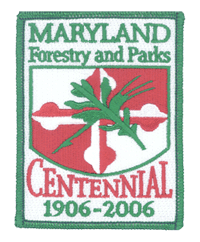 Fred W. Besley: Forestry Pioneer - Maryland’s First State Forester 1906-1942
Fred W. Besley: Forestry Pioneer - Maryland’s First State Forester 1906-1942
Part 2 of a 3-part series
Address by Francis “Champ” Zumbrun for the Maryland Forests Association Conference
Besley’s Noteworthy Achievements as a Forestry Pioneer
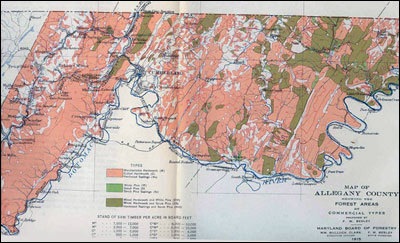
-
Besley pioneered statewide forest
inventories. He inventoried every stand of trees five acres and larger in size
in Maryland with a staff numbering fewer than the fingers on his hand. Besley
said: “I tramped every cow-path in Maryland making it.” This was a magnificent
accomplishment!
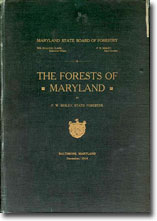 In 1916, he published the book, The Forests of
Maryland.
This was the first statewide forest survey published
in the country. On the cover of the hardbound edition, the name of W.
Bullock Clark, Maryland’s most respected scientist of that time is inscribed in
gold letters. Just left of Clark’s name is the name of Fred Besley, also gilded
in gold. Clark’s name in addition to Besley’s gave the forest survey additional
importance and respect.
In 1916, he published the book, The Forests of
Maryland.
This was the first statewide forest survey published
in the country. On the cover of the hardbound edition, the name of W.
Bullock Clark, Maryland’s most respected scientist of that time is inscribed in
gold letters. Just left of Clark’s name is the name of Fred Besley, also gilded
in gold. Clark’s name in addition to Besley’s gave the forest survey additional
importance and respect.
The quality and details of Besley’s county forest type
maps are incredible. It is more remarkable when one considers this was done
almost a century before GPS and ARC VIEW mapping technology existed. Besley
overlaid forest types over Bullock Clark’s county maps developed by the Maryland
Geological Survey.
McCoy Hall served as the location for the first office
for the State Board of Forestry (1906-1923) located at Johns Hopkins University
in Baltimore, Maryland, thus Besley’s first forestry office. On November 27,
1919, according to the Baltimore Sun newspaper archives, a fire destroyed McCoy
Hall.
More than 2,000 photographs and 600 lantern slides
were destroyed that couldn’t be replaced or restored. Fortunately for us,
Besley’s forestry inventory with its beautiful photographs and detailed maps was
published three years before the fire, preserving for posterity in book form his
initial pioneering field work as State Forester.
In 1923 the Board of Forestry was reorganized to the Maryland State Department of
Forestry. This administration change lasted from 1923 to 1941. Besley now
reported to a board of Regents at the University of Maryland in College Park.
Besley’s forestry office was eventually relocated by 1925 to the Fidelity
Building in Baltimore, a building still standing today. The Fidelity Building
served as Besley’s administrative office for the remaining time of his career
- Besley pioneered landscape photography.
Besley learned photography in Kentucky while doing forestry work under Gifford
Pinchot. More than 1,000 images, including glass lanternslides and photographs
taken after 1920, are preserved and archived at the Hall of Records in
Annapolis, Maryland.
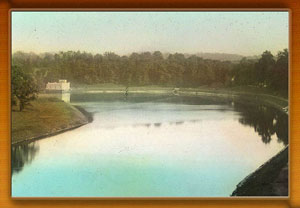
Besley left a meticulous photographic record of
Maryland’s early conservation efforts to restore the land. Some of his images
are of national geographic magazine quality. Besley was the king of
documentation. Almost all his photographs are dated, and include a subject
category, a location, and the name of the photographer.
- Besley pioneered “parketecture” in
Maryland.
He oversaw the development of facilities on public lands within the
State Forest and State Park Service, especially during the Civilian Conservation
Corps (CCC) period (1933-1942). The CCC built cabins and trails using native
material of stone and wood to blend in with the natural landscape. The idea was
to embrace nature, not conquer it.
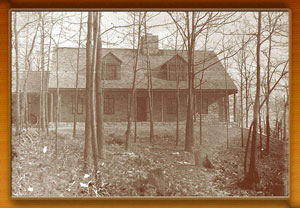
By 1933, Maryland’s State Forest reserves had grown
to about 50,000 acres. Thirteen CCC camps were constructed on state lands
between 1933-1942. As State Forester, Besley oversaw the development of
facilities on State public lands.
The CCC put young unemployed men to work on forestry
conservation projects. Just think of it – More than 2,600 young men were engaged
in conservation work at any one time in Maryland on forestry and park related
projects. What would we do for a work force like that now? During this time, the
young men built roads, erected fire towers, fought forest fires, and planted
millions of trees. Without a doubt, The CCC was the greatest conservation and
park development effort in history.
- Besley pioneered the Cooperative
Forestry Management Program in Maryland.
The Timber Marking Plan of 1913 marked
the beginning of Cooperative Forestry management in Maryland. Because of this
program, landowners of woodlots could benefit from the services and advice of
professional foresters. Besley’s program was years ahead of its time, many years
before federal assistance programs. Besley’s program was adopted across the
Country.
- Besley pioneered the implementation of
the Maryland Roadside Tree Law in 1914, the most progressive law of its kind in
the United States.
This law was the first to protect trees along roadways and
address problems of commercial signs along state roadways. This law was adopted
across the Country.
Besley was concerned with forest aesthetics and
roadside aesthetics. This is evident from the many photographs of roadside tree
care techniques, as well as photographs of redbud and dogwood in bloom along
roadsides adjacent to woodlands. Photographs along roadways show that Besley
worked hard to save big trees along roadways, even if it meant leaving one in
the middle of the road.
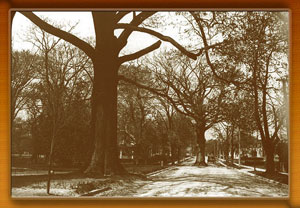
Helen Besley Overington noted, “Governor Ritchie was
great on helping Father. He was very proud of Maryland’s roads and he thought
they ought to be beautified.”
After the law was passed, for recreation on some
Sunday afternoons, Fred took his family out, armed with handsaws, to cut down
commercial signs along roadways that violated the law. The children fondly
remembered these activities.
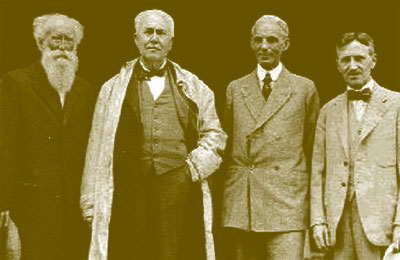
John Burroughs, Thomas Edison,
Henry Ford and Harvey Firestone
Besley’s career coincided with the growth of the
automobile industry, of which Henry Ford and Harvey Firestone are closely
associated. When time permitted, inventor Thomas Edison, along with
Industrialist Ford and Firestone liked to travel around the country together and
camp with their friend John Burroughs, a famous naturalist and nature writer.
On one of these vacations, they decided to visit
Maryland. Besley arranged for Abraham Lincoln “Link” Sines, a well-known Garrett
County Forest Warden, to act as their tour guide on their visit to Garrett
County.
Their trip included a visit to Swallow Falls State
Park. A story was recently told to me that during their visit to Garrett County,
they dropped by Naylor’s Hardware Store in Oakland for supplies.
Link introduced the men to Mr. Naylor, the storeowner.
The encounter went something like this:
Link said: “Mr. Naylor, I’d like to introduce you to
Thomas Edison; he invented that light bulb on your ceiling. This is Henry Ford;
he manufactured your car parked outside your store. This is Mr. Firestone; he
made the tires on your car.”
Mr. Naylor, a little skeptical by now, said to Link:
“And I suppose you’re going to tell me that this man with the beard is Santa
Claus!”
- Besley pioneered scientific forestry in
Maryland.
Besley and his foresters took pride in their professional
appearance. This is evident by their “go-to-church Sunday dress” in most of
their photographs. Very seldom are the foresters working in the woods without a
hat, coat, dress shirt, and tie.
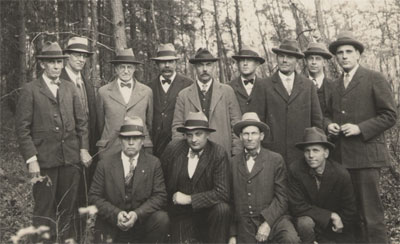
Besley established a variety of silviculture practices
and methods--shelterwood harvests, reforestation, thinning, plantings, retaining
seed trees, prescribed burns, streamside buffer management, crown management,
land erosion, and eliminating “pastured woodlots.” In Besley’s words,
“overgrazing …[fatal] for reproduction…caused thin soil cover and almost total
absence of old growth [advanced seedling/sapling establishment].” Besley’s
image of an ideal healthy forest was one protected from wildfires, where grazing
was eliminated - a forest where “healthy young growth, good ground cover, and
thrifty growing condition[s]” occurred.
Besley established responsible forest management
practices on both public and privately owned woodlands. He proved by example
and practice over his long productive career that conservation and preservation
concepts, properly applied in the right place at the right time, were necessary
for managing and maintaining healthy forested landscapes.
- Besley pioneered procedures and ways to
gain public support to acquire lands for State Forests and State Parks in
Maryland.
It is incredible accomplishment considering that Maryland went from
zero-acres of state public land before 1905 to nearly a half-a-million acres of
state public land in 2006. When Besley retired in 1942, there were about 100,000
acres of state public land. The groundwork was established and in place for
acquisition of additional lands for state public use.
- Besley pioneered state rights for
management of state public lands.
Besley believed State government could better
manage public lands and public parks than the federal government. Helen Besley
Overington sated, “Governor Ritchie was very much for State rights, as was my
father; Ritchie thought the closer to the people you got, the better it was, an
so did my father.”
In 1927, Besley helped gain public support for
legislation, giving the state primary rights to manage public lands over the
federal government. This may be one of the reasons there are no national forests
in Maryland today.
- Besley pioneered the concept of linking
scientific forestry with outdoor recreation.
He was always looking for ways to
gain public support and funding for forestry conservation and acquisition of
additional lands. He believed that promoting outdoor recreation on public lands
was one way to gain this support; that the public might be more likely to
support the State in their efforts to purchase additional lands to practice
scientific forestry.
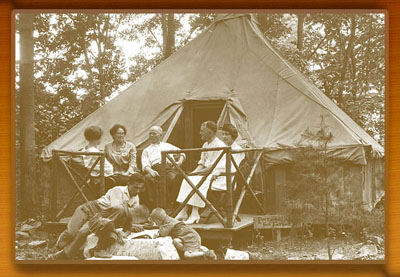
Helen Besley Overington stated, “Father believed that
forest should not only be conserved, but that they should be used. Father was
very interested in getting the public to use the land. Father thought this would
bring more public support for conservation.”
In the early 1900’s, camping in the outdoors for fun
was a rater new concept to urban residents from Baltimore. Many thought that
the only people who camped in tents were either in the Army or were suffering
hard times.
Besley and his family camped sometimes a month at a
time along Cascade Falls at Patapsco State Park. The public read in Baltimore
Sun newspaper advertisements inviting them to visit the State Park and learn
about camping. When they showed up, there would be the Besley family, giving
public demonstrations how to set up camp and cook.
- Besley pioneered outdoor recreation in
Maryland.
In 1940, Besley brought the sport of skiing into Maryland at New
Germany State Park. Many skeptics thought that a ski slope constructed south of
the Mason-Dixon Line was not commercially viable; they thought the snow would
melt too quickly. Besley proved them wrong!
.jpg)
Besley handpicked Joe Davis, a forester and Eagle
Scout, to build this slope. Since Davis had never built a Ski slope before, to
do the job, he used a Boy Scout skiing merit badge book for a guide and CCC
enrollees that were former Boy Scouts. It was a great success!
- Besley pioneered and championed the
development of the Maryland State tree nursery (1914). The first Tree Nursery
was in operation at College Park by 1914. Besley brought to Maryland the
experience and knowledge he gained working as Superintendent at the Tree Nursery
in Halsey, Nebraska, in 1904. Halsey Tree Nursery was the first U.S. Forest
Service Tree Nursery in the country. The establishment of the tree nurseries
aided greatly to efforts regarding forest ecological restoration.
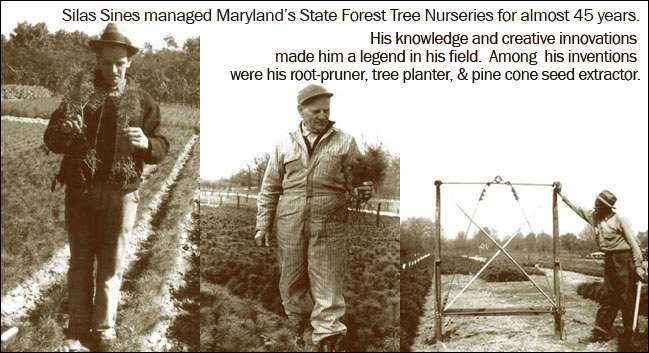
Silas Sines Sr. was the
superintendent of the Maryland State Tree Nursery for more than 40 years
(1929-1974). Besley handpicked him for the job. Sines was a pioneer in his
own right; he developed a root-pruner and pine cone seed extractor that the
federal government studied to adopt for their use.
During his tenure Besley established four state tree
nurseries: three at College Park, and one at Beltsville. Fred W. Besley would
say: “The best time to plant a tree was twenty years ago – the second best time
is today.”
- Besley pioneered environmental
education.
His presentations included topics about roadside tree care, forest
pests and diseases, and dendrology (tree identification).
Besley used a lanternslide projector with glass slides
to enhance his presentations. His lanternslide programs didn’t occur just in a
sterile, classroom environment; he often took his programs on the road,
presenting them in an open field near woodland.
|
Helen remembers being with her father at these
lanternslide programs. “ She recalled, “Father would jack up the back end of the
car, and to power up the lantern slide projector [for the light bulb], attach a
belt from the axle to the projector [generator].” He hung a sheet on a tree,
stood beside it in front of the audience while in the back, his children
switched the slides back and forth on the projector. Helen remembered, “People
were crazy [enthusiastic] to see them.” |
>br />
Judging by his accomplishments as a leader and
speaker, Besley, like Pinchot, had a gift to inspire people and motivate them
into positive action. Helen said, “Father was a great story teller…he
especially loved to tell “Paul Bunyan stories.” A heading from a newspaper
article state this about Besley: “His Stories are as Tall as the Trees He
Protects.”
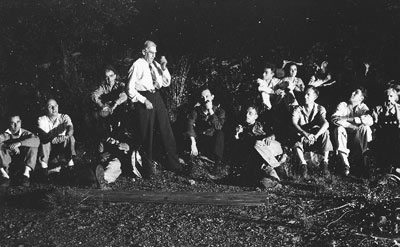
A photograph exists showing Besley conducting a
campfire program at Green Ridge State Forest in 1941, one year before his
retirement. Besley is surrounded by campers in casual clothing while Besley
stands in the middle of them looking like he’s just walked out of church wearing
a white shirt and tie. The campers’ faces without exception are all turned on
Besley; whatever story he is conveying has certainly captured the campers
complete attention.
- Besley pioneered the Champion Big Tree Program.
Indeed, the roots of the champion tree program are planted in Maryland! It all
started right here! In 1925, Besley developed the program and standardized the
method for measuring the large trees that were later adopted across the country.
Besley was concerned with preserving Maryland’s last remnants of old growth,
which he called “original growth.” Besley is indeed the “Father of the Big Tree
Contest.”
Besley stated that Maryland’s woodlands were
“devastated” at the beginning of the twentieth century, consisting of cutover
landscapes, and seedling/sapling-sized forests. In Besley’s words, “careless
lumbering… culled the best, left much slash on the ground, with “the natural
consequence of waste like this…forest fire.”
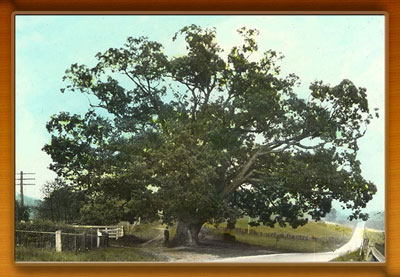
Besley was concerned with preserving the last remnants of old growth in
Maryland. Note: There are hundreds of pictures of large, old trees (“noted tree”
is how he labeled many of these pictures), trees that were surviving remnants of
Maryland’s original forests. This concern led to the Champion Big Tree Program,
now conducted across the country. Apparently, to see a big tree back then was
like seeing a bald eagle today; a picture of the tree with a person standing
next to it had to be taken when you came across a titan tree.
Many
of his lanternslides are of large, old trees that he labeled “noted tree.” To
Besley, titan trees like this represented remnants of the original pre-colonial
forests.
Apparently, to see a big tree back then was equivalent to the experience we feel
when we see a bald eagle – it is special. Of
course, with Besley’s special interest in photography, he would have to stop and
take a picture of a tree with a person standing next to it.
In
some of the earlier photographs of the early 1900’s one could see why Besley was
concerned. There were few large trees left in the landscape. Some of the farms
in western Maryland were especially depleted of soil where forests once grew. It
was tough scratching a living and growing anything on these farms. I heard it
said that the soil was so poor in some of these areas, that you couldn’t even
raise hell with a gallon of whiskey!
- Besley practiced “sustainable” forest
resource management before the word “sustainable” became a buzz-word. Because of
World War II and efforts to supply the war effort, Besley was concerned timber
removal was approaching levels of peak year (1909) when 44 ½ billion board ft.
was cut at the end of the “Age of Forest Exploitation.” He wrote about the need
to enforce the concept of forest regulation so that timber removal never again
exceeded overall growth.
- Besley pioneered methods to gain public
support for forest conservation.
Besley developed Maryland’s first systematic methods of fighting forest fires by
using commissioned forest wardens. Besley personally handpicked these wardens,
seeking out individuals who were pillars of the community. Forest wardens were
involved in a variety of activities, from fighting wildfires to providing
political clout when called upon to support Besley’s conservation initiatives.
He proved the best way to preserve forestland from threats is to involve the
community and arm them with information that responsible forest management on
public lands and private lands is not only good for the environment, but also
beneficial to both the community and economy. In 1920, there were 150 forest
wardens; in 1935 there were 650 forest wardens.
- Besley pioneered methods to fight and
detect forest fires. In the 1920’s, fire control was prominent in the mind of
Besley. He wrote in a 1920’s report that one of the important functions of the
Department is to “organize and maintain a system of state-wide forest protection
for 2,200,000 acres of forestland in the State.”
He
must have had a very effective program. He wrote in 1920 that the average forest
fire was 203 acres; by 1927, the average size of a fire was reduced to 17 acres.
By 1920, there were at least three fire towers, all in
Garrett County. About 42 fire towers were constructed during Fred Besley’s
tenure throughout the State.
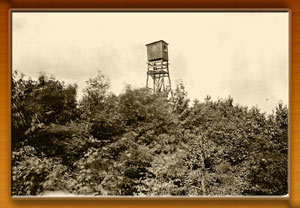
In
Besley’s words, forest fires “impoverished soil, destroyed reproduction, and
[caused] damage [to] the large trees.” Through his foresters like Joe Davis,
Besley pioneered building a fire line around a wildfire using the “two-lick
method.” In the 1920’s fire control was prominent in Besley’s mind. He wrote in
a 1920’s report that one import function of his Department was “to organize and
maintain a state-wide forest protection for 2,200,000 acres of forest land in
the State.” His program was very effective, reducing the average size of a
forest fire from 203 acres in 1920 to 17 acres in 1927. In 1916, only
three fire towers stood, all in Garrett County, by 1942, during Fred Besley’s
tenure as State Forester, 42 fire towers were constructed. Fire towers
established an early romantic stereotype of the forest service. Today, the fire
towers that still stand serve as monuments to the early forest conservation
movement.
Acknowledgements:
Address by Francis “Champ”
Zumbrun for the Maryland Forests Association Conference Centennial Kick-off,
November 5, 2005. Francis
"Champ" Zumbrun is the forest manager at Green Ridge State Forest. He has
worked as a professional forester for DNR since 1978. He serves on the Forestry
and Parks Centennial Committee. He is currently looking for an alidade to place
in the Town Hill lookout fire tower at Green Ridge State Forest.
The author would especially like to thank Ross Kimmel, Robb Bailey, Offutt Johnson, Helen Besley Overington, Kirk Rodgers, Mary Rotz, Don and Peggy Weller, Rob Schoeberlein of the Maryland State Archives, and Silas Sines, Jr. for graciously providing historical documents,
photographs and source materials that greatly helped in the preparation of this article.
Photographs (top to
bottom):
-
Map depicting Forest Survey of Allegany County, 1915
-
Book Cover, The Forests of Maryland
-
Loch Raven, looking downriver from the new dam to the old dam,
1920s, photo by Fred W. Besley
-
Caretaker's House, Gambrill State Park, 1930s
-
Large tree left in middle of the road, with cars passing.
Easton, Maryland, 1920s
-
John Burroughs, Thomas Edison, Henry Ford and Harvey Firestone
-
Fred W. Besley (on far left wearing a State-issued jacket) and his foresters posing in the field
-
Camping at the Patapsco Forest Reserve.
-
Getting ready for a day on the slope at New Germany State Park
-
Photo collage of Silas Sines, Sr., manager of Maryland's State
Forest Tree Nurseries for almost 45 years (1929-1974)
-
Fred W. Besley telling story at campfire in Greenridge State
Forest, Maryland Mountain Club, 1941
-
Richards Oak near Rising Sun, with person at base of large tree
for scale, 1920s
-
Snaggy Mountain Fire Tower